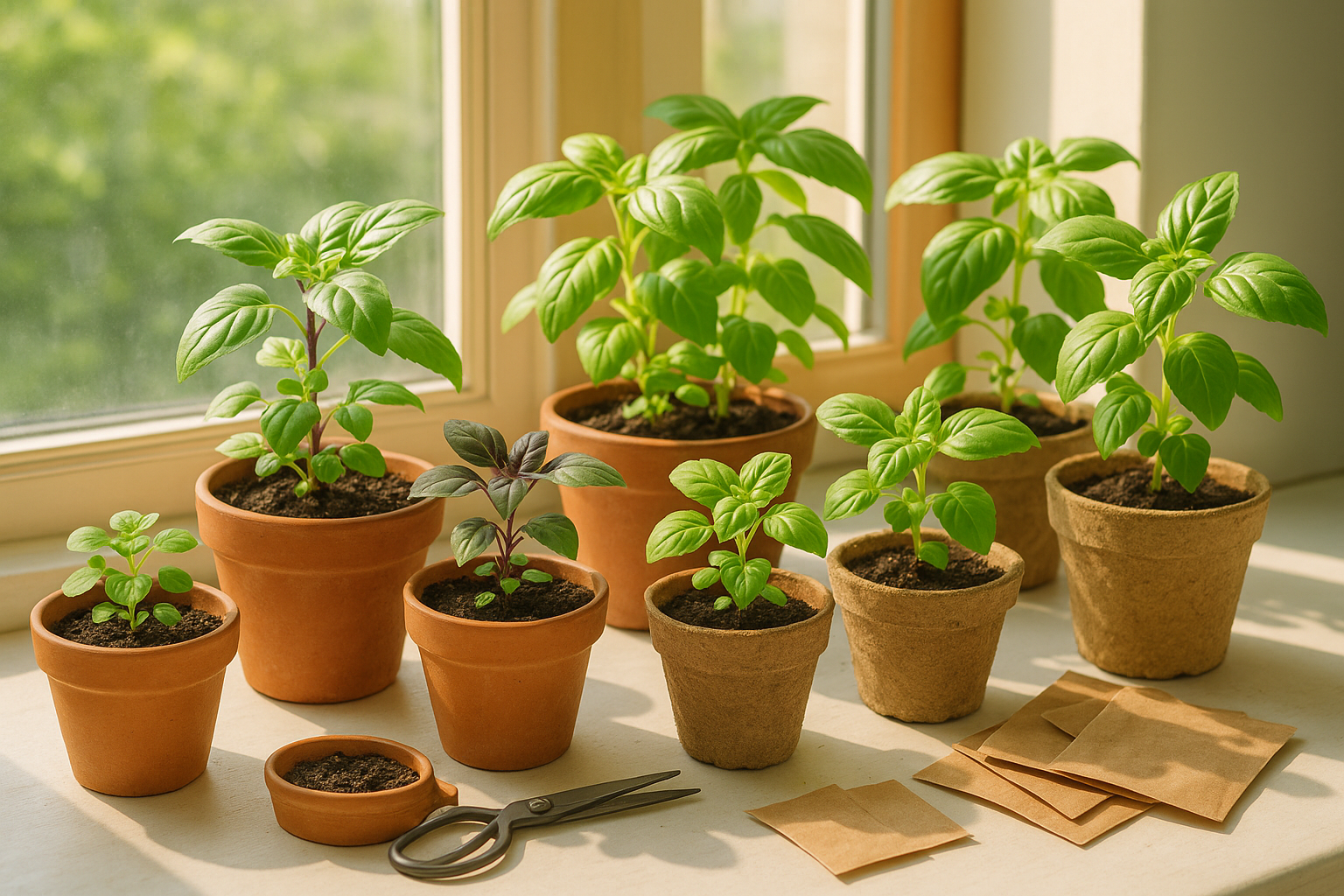Introduction to Growing Basil from Seed
If you’ve ever wondered how to grow basil from seed, you’re not alone—this fragrant herb is a favorite in kitchens worldwide. Basil adds fresh flavor to everything from Italian pasta sauces to Southeast Asian curries, but store-bought bunches often wilt quickly and limit you to just a few varieties.
By starting basil from seed, you can choose from an exciting array of types, from classic Genovese to spicy Thai and lemony varieties, ensuring homegrown freshness at your fingertips. Growing basil from seed not only saves money—a single packet can yield dozens of plants—but also lets you harvest just what you need, right when you need it, for maximum flavor.
In this complete guide, we’ll walk you through every step of the process—from sowing your first seeds indoors or outdoors to nurturing your young seedlings and providing the optimal conditions basil loves. You’ll also learn tips for ongoing plant care, pest management, and when and how to harvest leaves for the fullest flavor.
Whether you’re a total beginner or a seasoned gardener looking to take your basil game to the next level, this article will set you up for aromatic success all season long.
Choosing the Right Basil Variety
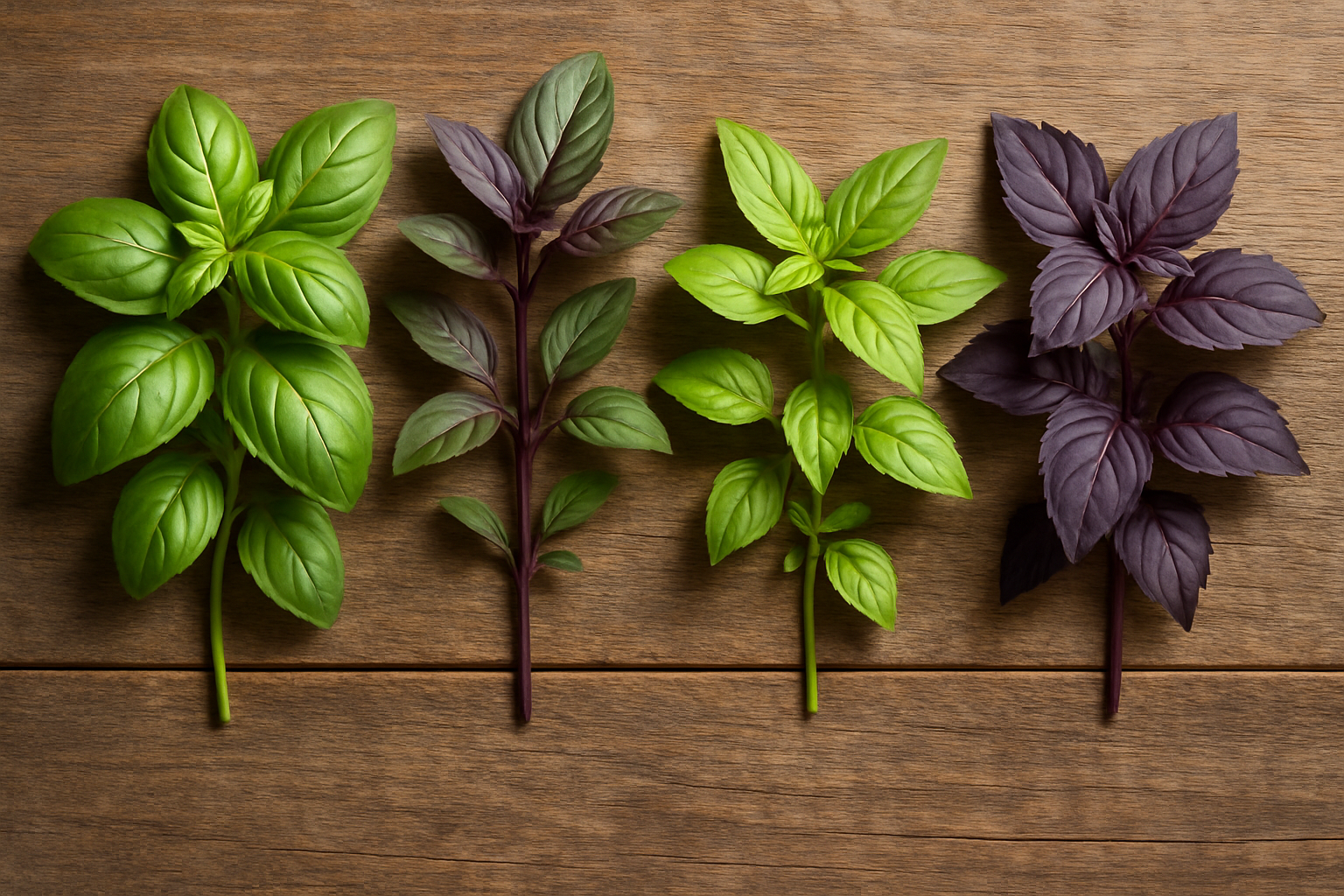
With so many basil varieties to choose from, finding the perfect one for your garden and kitchen can be an adventure in flavor. Sweet basil is the classic choice, boasting large, tender leaves and a versatile, slightly peppery taste that’s perfect for pesto, caprese salads, and Italian dishes.
If you love Asian cuisine, Thai basil offers a spicy, licorice-like aroma and narrower leaves that hold up well in stir-fries and curries. For a citrusy twist, lemon basil brings a zingy freshness that pairs beautifully with fish, chicken, or summer beverages. Purple basil isn’t just striking in the garden—its deep violet leaves have a mildly spicy flavor and make a beautiful garnish or colorful addition to salads and vinegar infusions.
Each variety has unique growth habits: sweet basil needs warmth and regular pinching to stay bushy, while Thai and lemon basils are generally more compact and can tolerate higher temperatures. Purple basil grows like sweet basil but may need extra sunlight to maintain its vibrant color.
When choosing a variety, think about your climate—a sunny, warm spot is best for all types, though compact basils like Greek or globe basil thrive even in pots or smaller spaces. Consider your favorite dishes and flavors: grow sweet basil for Italian cooking, Thai basil for Southeast Asian flair, or try a mix to experiment with new tastes.
If you’re new to basil, start with one or two types and branch out as you discover your favorites.
When and How to Sow Basil Seeds
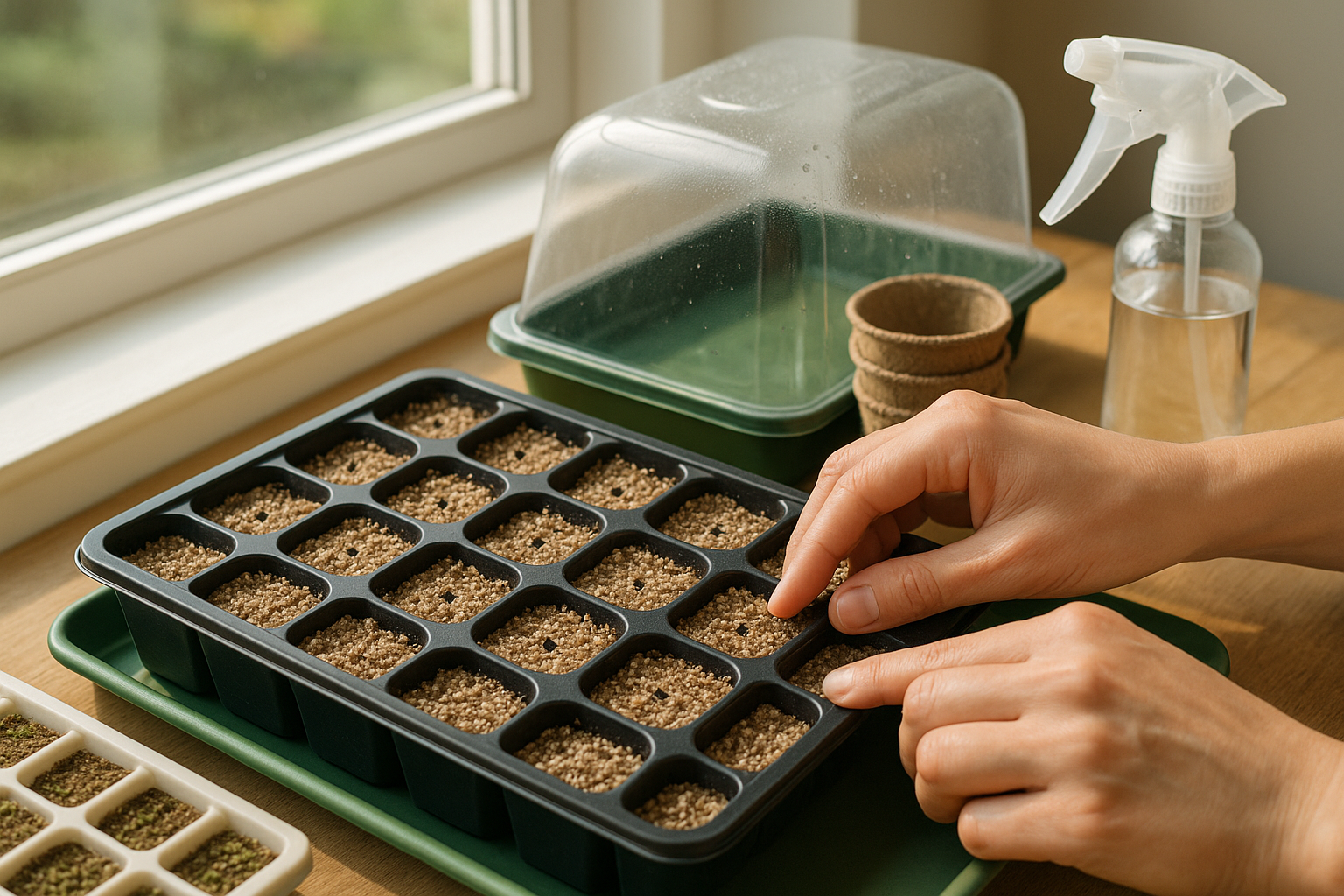
For the best results, start basil seeds indoors 6-8 weeks before your last expected spring frost. This gives your seedlings a head start before transplanting them outside. If you prefer sowing directly outdoors, wait until temperatures consistently stay above 50°F (10°C), as basil is sensitive to cold.
To begin indoors, choose shallow trays or small pots with drainage holes. Biodegradable peat pots or seedling trays are ideal because they make transplanting easier and reduce root disturbance. Fill containers with a light, sterile seed-starting mix—avoid heavy garden soils that may compact and hinder sprouting.
Gently press basil seeds into the surface of the soil, covering them lightly with no more than 1/4 inch (0.5 cm) of mix, as basil seeds need some light to germinate. Place trays in a warm, bright spot like a sunny windowsill or under grow lights for at least 6 hours a day. Basil thrives on warmth, so aim for temperatures around 70°F (21°C).
For higher humidity, cover the containers with a clear plastic dome or wrap (vented daily to prevent mold). This keeps moisture high while seeds sprout. Mist gently to keep the soil damp but not soggy—overwatering can lead to damping off, a common seedling disease.
If starting outdoors, sow seeds after all danger of frost has passed and the soil has warmed. Plant seeds about 1/4 inch deep and thin seedlings to 6-12 inches apart for good airflow and healthy growth.
Whether indoors or outdoors, patience pays off—basil seeds usually sprout within 5-10 days. Providing steady warmth, light, and gentle watering will help ensure a lush, aromatic crop all season long.
Caring for Basil Seedlings and Plants
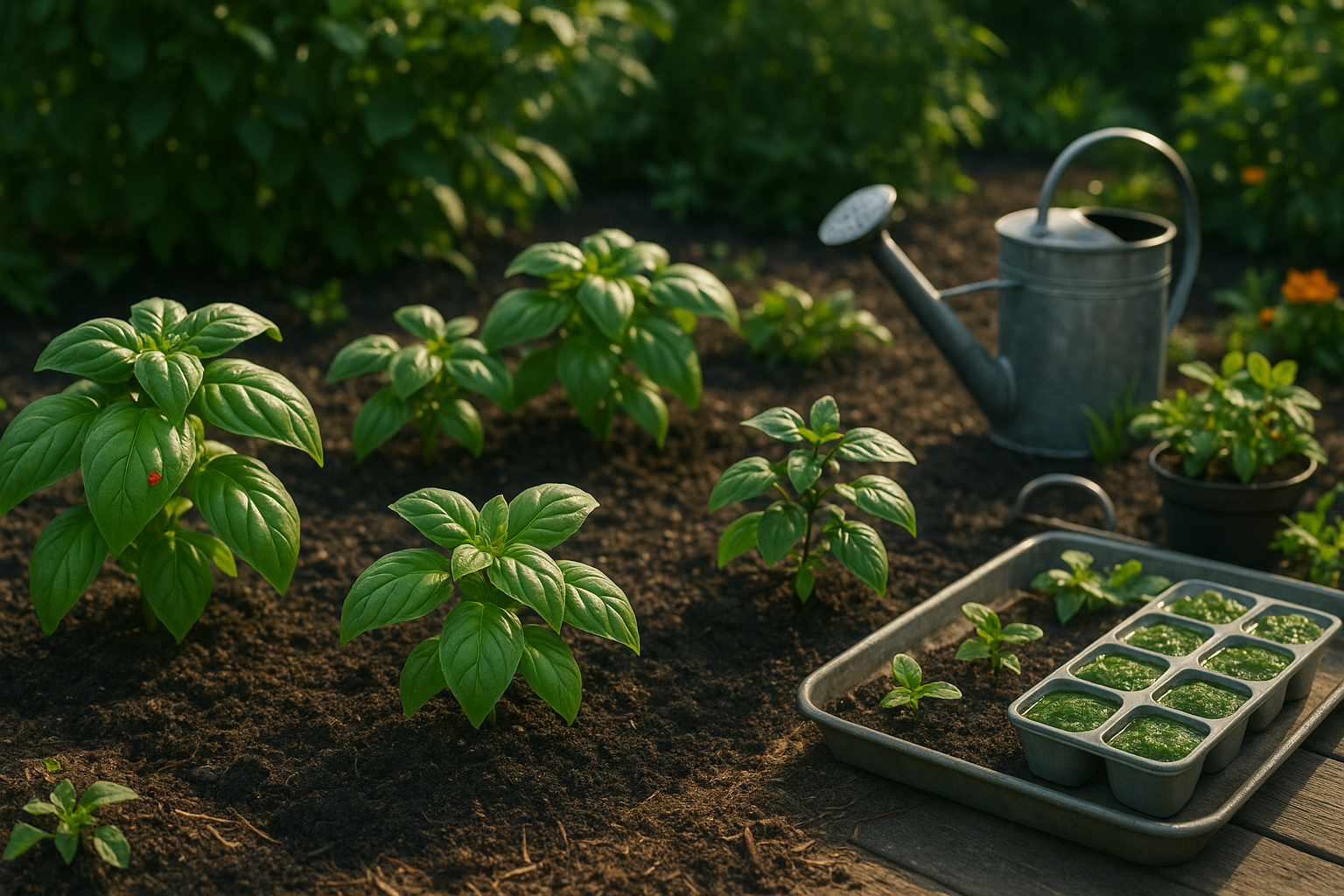
Caring for basil seedlings and mature plants is simple once you understand what they need at each stage. Start by thinning your seedlings after they develop at least two sets of true leaves—space them about 6–12 inches apart to give each plant enough room for airflow and root growth. Overcrowding can lead to weak stems and increased susceptibility to disease.
If you started seeds indoors, transplant them outside when nighttime temperatures stay above 50°F. Handle them gently, keeping as much soil around their roots as possible. Basil thrives in spots with full sunlight, receiving at least 6 hours of light daily, so choose a sunny windowsill or a bright garden bed.
Use well-draining soil rich in organic matter, and keep it consistently moist but not soggy; a layer of mulch can help retain moisture. Water basil in the morning at the base of the plant to prevent fungal diseases.
For bushy, productive plants, pinch off the growing tips regularly—especially before the plant flowers. This encourages side branches and a fuller shape. Fertilize basil every 3–4 weeks with a balanced, water-soluble fertilizer, but avoid overfeeding, which can negatively affect the flavor.
Keep an eye out for pests such as aphids or Japanese beetles. Try spraying with soapy water or removing bugs by hand as soon as you notice them. Check leaves for signs of fungal disease, like black spots or wilting, and remove affected areas promptly.
With these simple steps, your basil will reward you with lush, aromatic leaves all summer long—perfect for tossing into salads, pasta, or your favorite pesto.
Harvesting and Storing Basil
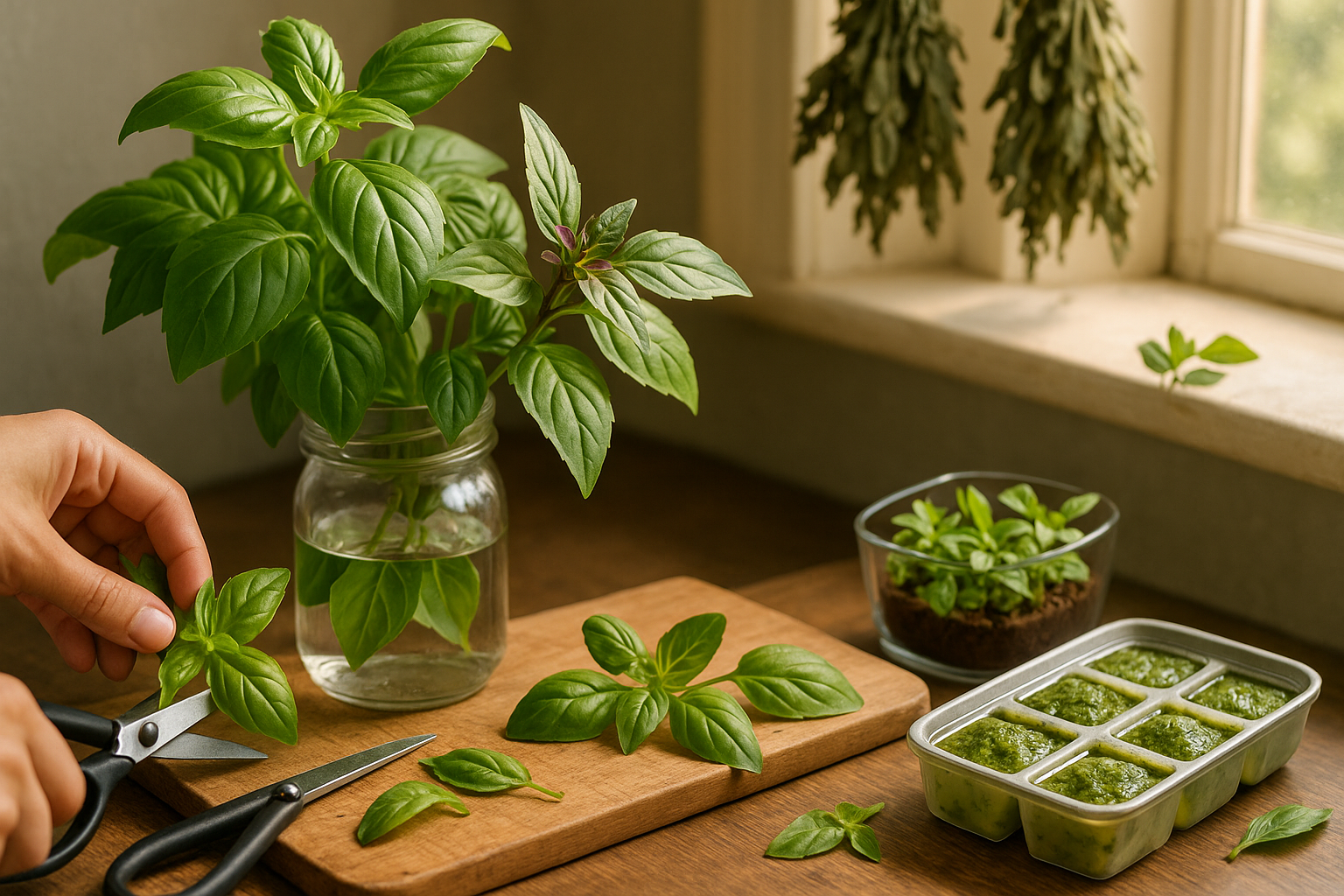
Basil is ready to harvest once its leaves are a vibrant green and the plant has grown to at least 6–8 inches tall, usually about six weeks after planting. The best way to harvest is to snip leaves or stems just above a pair of leaves, using clean scissors or your fingers. This encourages the plant to branch out and produce more foliage. Avoid taking more than one-third of the plant at a time to keep it healthy.
Regular harvesting, at least once a week, prevents basil from flowering and keeps the leaves tender—pinching off any flower buds as soon as they appear is another key tip.
When it comes to storing your harvest, fresh basil can be kept in a glass of water at room temperature, like a bouquet, or wrapped in a damp paper towel inside the fridge. Both methods help the leaves stay fresh for up to a week.
For long-term storage, you can chop basil and freeze it with a little water or olive oil in ice cube trays—a perfect way to add flavor to soups or sauces all year. Alternatively, drying is another straightforward method: hang basil stems upside down in a cool, dry place until they’re crisp, then crumble and store in an airtight container. This way, you can enjoy homegrown basil flavor even during the colder months.
Common Problems When Growing Basil (and Solutions)
Growing basil can be incredibly rewarding, but many gardeners encounter a few common challenges along the way. One of the biggest issues is pest infestation—aphids, spider mites, and Japanese beetles love basil’s tender leaves. To combat these pests organically, spray your plants with a mixture of water and a few drops of mild dish soap, or release ladybugs in your garden to naturally reduce pest populations.
Disease is another frequent problem, especially fungal issues like downy mildew or Fusarium wilt, both of which thrive in damp conditions. To prevent these, water basil at the base (not overhead) and ensure good air circulation by spacing plants about 12 inches apart.
Environmental stress, such as too much direct sun or inadequate watering, can lead to wilting, yellowing, or stunted growth. Keep soil consistently moist but not soggy, and mulch around the base of each plant to retain moisture and deter weeds.
Always select disease-resistant basil varieties if possible, and avoid planting new basil in the same spot each year to reduce the buildup of soil-borne pathogens. Starting your basil indoors before the last frost and gradually hardening it off can also toughen young plants against garden stress.
By combining these organic solutions and preventative strategies—like rotating crops, optimizing plant spacing, and monitoring for early signs of trouble—you’ll give your basil the best chance to thrive and enjoy an abundant, flavorful harvest all season long.
Final Tips for Basil Success
Growing basil from seed to harvest is rewarding and easier when you start with high-quality seeds, provide plenty of sunlight (at least six hours daily), and keep the soil consistently moist but not soggy. Regularly pinch off the top sets of leaves to encourage bushier growth and prevent early flowering, which helps your plant yield more fragrant leaves.
It’s best to water basil at the roots—wet leaves attract fungal diseases—so use drip irrigation or water in the morning. Feeding basil lightly with organic fertilizer every few weeks can boost growth, and mulching helps conserve moisture while keeping weeds at bay.
Look out for common pests like aphids and harvest leaves frequently to keep the plant productive; the more you pick, the more basil you’ll have. If you’re short on space, basil thrives in pots on sunny windowsills as well as in garden beds.
Don’t be afraid to experiment with various basil varieties like Genovese, Thai, or Lemon basil to find your favorite flavors. Use your fresh harvest in everything from pestos and salads to cocktails.
Most importantly, enjoy the process—basil is forgiving and responds well to attentive care, making it perfect for both beginners and veteran gardeners alike.
